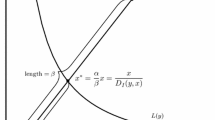Abstract
The Malmquist productivity index is based on distance functions, which are reciprocals of radial Debreu-Farrell efficiency measures, and which have a number of desirable properties. Linear programming techniques are frequently employed to calculate the efficiency measures. However these techniques can leave slacks, which constitute a non-radial form of inefficiency which is not incorporated into the analysis. Thus a radial efficiency measure overstates true efficiency, the reciprocal distance function understates the distance to the relevant efficient subset, and the Malmquist productivity index is adversely affected, although in an analytically indeterminate direction. This has led us to consider a new definition of “one-sided” efficiency, and to develop a new nonradial efficiency measure which incorporates all slacks on the selected side. Replacing conventional radial efficiency measures with our new non-radial efficiency measures generates what we call a quasi-Malmquist productivity index. We illustrate our quasi-Malmquist productivity index with an application to productivity change in Spanish banking.
Similar content being viewed by others
References
Aida, K., W. W. Cooper and J. T. Pastor. (1996). “Evaluating Water Supply Services in Japan with RAM–A Range-Adjusted Measure of Efficiency.” Research Report. Austin, Texas: University of Texas, Graduate School of Business.
Althin, R. (1995). Essays on the Measurement of Producer Performance. Lund Economic Studies No. 60. Department of Economics, Lund University, S 220-07 Lund, SWEDEN.
Balk, B. (1993). “Malmquist Productivity Indexes and Fisher Ideal Indexes: Comment.” The Economic Journal 103:415 (May), 680–682.
Banker, R. D., A. Charnes and W. W. Cooper. (1984). “Some Models for Estimating Technical and Scale Inefficiencies in Data Envelopment Analysis.” Management Science 30:9 (September), 1078–1092.
Briec, W. (1996). “Metric Distance and Measurement of Technical Efficiency.” Working Paper, Maitre de Conférences en Sciences Economiques è l'Université de Rennes 1, IGR-IAE, 11 Rue Jean Macé, 35000 Rennes, FRANCE.
Caves, D. W., L. R. Christensen, and W. E. Diewert. (1982). “The Economic Theory of Index Numbers and the Measurement of Input, Output, and Productivity.” Econometrica 50:6 (November), 1393–1414.
Charnes, A., W. W. Cooper, and E. Rhodes. (1978). “Measuring the Efficiency of Decision Making Units.” European Journal of Operational Research 2:6, 429–444.
Cooper, W.W., and J. T. Pastor. (1996). “Generalized Efficiency Measures (GEMs) and Model Relations for Use in DEA.” Working Paper, Graduate School of Business, University of Texas, Austin, TX 78712, USA.
Debreu, G. (1951). “The Coefficient of Resource Utilization.” Econometrica 19:3 (July), 273–292.
Farrell, M. J. (1957). “The Measurement of Productive Efficiency.” Journal of the Royal Statistical Society Series A, General, 120, 253–281.
Färe, R. (1988). Fundamentals of Production Theory. Berlin: Springer-Verlag.
Färe, R., and S. Grosskopf. (1992). “Malmquist Indexes and Fisher Ideal Indexes.” The Economic Journal 102:410 (January), 158–160.
Färe, R., S. Grosskopf, B. Lindgren and P. Roos. (1992). “Productivity Changes in Swedish Pharmacies 1980–1989: A Non-Parametric Malmquist Approach.” Journal of Productivity Analysis 3:1/2 (June), 85–101.
Färe, R., S. Grosskopf, B. Lindgren, and P. Roos. (1994). “Productivity Developments in Swedish Hospitals: A Malmquist Output Index Approach.” In A. Charnes, W.W. Cooper, A. Y. Lewin, and L. M. Seiford (eds.), Data Envelopment Analysis: Theory, Methodology and Applications. Boston: Kluwer Academic Publishers.
Fisher, I. (1922). The Making of Index Numbers. Boston: Houghton-Mifflin.
Frei, F., and P. Harker. (1996). “Projections onto Efficient Frontiers: Theoretical and Computational Extensions to DEA.” Working Paper, Simon School of Business, University of Rochester, Rochester, NY 14627, USA.
González, E., and A. Alvarez. (1996). “The Shortest Path to the Efficient Subset.” Working Paper, University of Oviedo, Oviedo, SPAIN.
Koopmans, T. C. (1951). “An Analysis of Production as an Efficient Combination of Activities.” In T. C. Koopmans (ed.), Activity Analysis of Production and Allocation. Cowles Commission for Research in Economics Monograph No. 13. New York: Wiley.
Lovell, C. A. K., J. T. Pastor, and J. A. Turner. (1995). “Measuring Macroeconomic Performance in the OECD: A Comparison of European and non-European Countries.” European Journal of Operational Research 87, 507–518.
Malmquist, S. (1953). “Index Numbers and Indifference Surfaces.” Trabajos de Estadística 4, 209–242.
Pastor, J. T. (1994). “New Additive DEA Models for Handling Zero and Negative Data.” Working Paper, Departamento de Estadística e Investigacíon Operativa, Universidad de Alicante, 03071 Alicante, SPAIN.
Pastor, J. T. (1995). “How to Discount Environmental Effects in DEA: An Application to Bank Branches.” Working Paper, Departamento de Estadística e Investigación Operativa, Universidad de Alicante, SPAIN.
Russell, R. R. (1988). “On the Axiomatic Approach to the Measurement of Technical Efficiency.” In W. Eichhorn (ed.), Measurement in Economics. Heidelberg: Physica-Verlag.
Thompson, R. G., R. M. Thrall, and G. Zheng. (1996). “DEA Malmquist Index Application Considering Slacks.” Working Paper, Department of Decision and Information Sciences, University of Houston, Houston, TX, USA.
Torgersen, A. M., F. R. Førsund, and S. A. C. Kittelsen. (1996). “Slack Adjusted Efficiency Measures: The Case of Norwegian Labour Employment Offices.” Journal of Productivity Analysis 7:4 (October), 379–398.
Törnqvist, L. (1936). “The Bank of Finland's Consumption Price Index.” Bank of Finland Monthly Bulletin 10, 1–8.
Zieschang, K. D. (1984). “An Extended Farrell Technical Efficiency Measure.” Journal of Economic Theory 33:2 (August), 387–396.
Author information
Authors and Affiliations
Rights and permissions
About this article
Cite this article
Grifell-Tatjé, E., Lovell, C.A.K. & Pastor, J.T. A Quasi-Malmquist Productivity Index. Journal of Productivity Analysis 10, 7–20 (1998). https://doi.org/10.1023/A:1018329930629
Issue Date:
DOI: https://doi.org/10.1023/A:1018329930629




